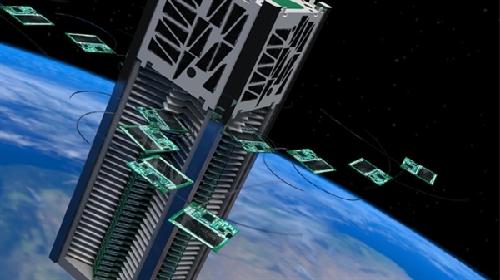(单词翻译:单击)
If all goes as planned, a group of U.S. university students will have placed a satellite powered exclusively by water, into orbit around the moon in just over a year.
如果一切都按计划进行得很顺利,一群美国大学生就可以在一年内将一颗只用水作为动力的卫星送到月球轨道里。
The Cornell University team CisLunar Explorers (cislunar means "between Earth and the moon") and their eponymously named satellite - actually two adjoining satellites - are taking part in a NASA program called the Cube Quest Challenge.
康奈尔大学"地月空间探索者"团队("地月空间"的意思是"在地球和月球之间")和他们的同名卫星--其实是两颗连在一起的卫星--参加了美国宇航局一项叫作"立方任务挑战"的项目。
The challenge is simple: design, build and deliver "flight-qualified, small satellites capable of advanced operations near and beyond the moon."
挑战很简单:设计、制作和发射"具备空间飞行资格、能够在月球附近和外部进行高级操作的小型卫星"。
Nothing to it, right? Evidently not, because there are 10 teams that are competing in the challenge with names like "Cubequestador" and "Eagles Quest."
这没什么难的,是吧?确实如此,因为有10支名字类似"立方探索"、"飞鹰行动"的队伍也参加了这项挑战。
But the CisLunar Explorer satellites are unique because the only form of propulsion on board these these two small L-shaped craft is water.
但是"地月空间探索者"卫星是特别的,因为这两个小型的L型飞行器的唯一动力就是水。

The idea is the brainchild of Mason Peck who works at Cornell University but used to be NASA's chief technologist. He has always wanted to figure out a way to get beyond rockets as a way to push our spacecraft beyond earth.
这个想法是前美国宇航局首席技术专家、现在在康奈尔大学工作的马森·派克的创意。他总是想要想出火箭之外的宇宙飞行器动力。
"A lot of the mass we send into orbit these days is in the form of rockets – the only way we get anything into space," he said in a Cornell press release.
"这些日子以来,我们送到轨道里的很多东西都是用火箭作为推进器的--这也是唯一一种推进器。"他在康奈尔大学新闻发布会上说道。
"But what if we could use what's already there? If we could do that, if we could refuel spacecraft while they're already in space..."
"但是如果我们用现成的东西怎么样呢?如果我们能做到的话,如果我们能够给空间里的飞行器补充燃料的话……"
Here's how it works: The craft is two connected satellites that will gradually separate from each other, both shaped like the English letter "L." Water is stored in the lower part of the L.
它的工作原理是这样的:这两颗L型卫星是连在一起的,但是会逐渐分开。水储存在L型的低端。
Energy from the sun will electrolyze the water into its two parts, hydrogen and oxygen.
来自太阳的能量将水电解为氢气和氧气。
Put the hydrogen, oxygen and a spark together and you get a bang that provides thrust, with water as the only by-product.
氢气、氧气和火星在一起会爆炸,产生巨大的能量,而副产品只有水。
And it turns out water is pretty plentiful out in space. Icy comets are full of it, and NASA is currently in the process of looking for it on a number of rocky near-earth asteroids.
并且,水在空间里是相当大量的。冰彗星上全是水,并且现在美国宇航局正在寻找一种全是岩石的近地小行星。
The newest theories suggest that most of the water on our planet may have come from asteroids or comets when the ancient Earth was being bombarded with space junk in its formative years.
最新理论表明,我们星球上的大部分水可能是古代地球在形成过程中遭到来自小行星或者彗星的空间垃圾轰击之后的产物。
Another cool thing about the CisLunar Explorer is how the team is teaching it to navigate its way through space.
另一件关于"地月空间探索者"很酷的事是:这个团队正在调教卫星进行空间自动导航。
The idea is to copy how ancient mariners used the moon, sun and stars to fix their position on the oceans.
这个想法是来自于古代航海家利用月亮、太阳和星星的位置来确定自己在海上的位置。
Once the twin satellite halves separate after launch they will spin around each other on their way to the moon to keep them from going off course.
在发射之后,两颗双子卫星一旦分离,就会在前往月球的路上相互旋转,防止偏离路线。
They will be equipped with cameras and be constantly taking pictures of the sun, Earth and the moon, and comparing their positions and their size.
团队会给他们装上摄像机,持续不断地给太阳、地球和月球拍照,与他们的位置和大小相对比。
Based on where the sun, moon and Earth are at any given moment, the CisLunar Explorers will do the math to figure out their position.
基于太阳、月球和地球的实时位置,"地月空间探索者"就可以算出它们的位置。
Of the 10 teams competing, the top three winners will hitch a ride on board NASA's space launch system in early 2018.
在10支参赛团队中,前三名将有机会搭载上美国宇航局2018年初的空间发射系统。
The competition is in four stages and the Cornell team has been in the top three in stages one and two.
比赛分为四个环节,康奈尔大学代表队在第一和第二环节都是前三名。
The winners of this third stage will be announced in about a month, and the final three winners will be announced in early 2017.
第三环节的胜者将在大约一个月之后宣布,而最终的前三名将在2017年初宣布。


